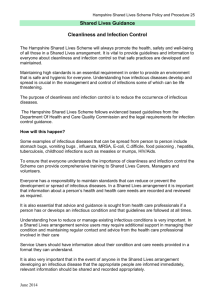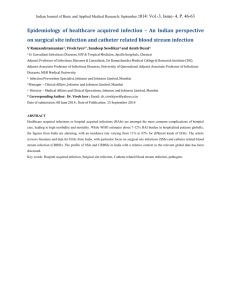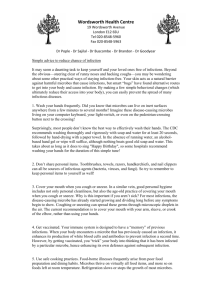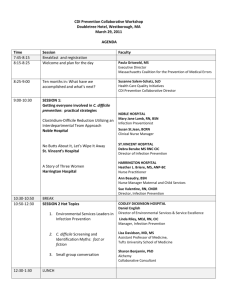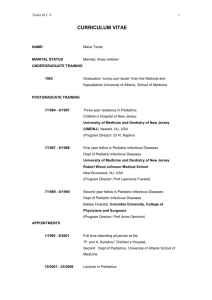Supplemental Table of IDSA Treatment
advertisement
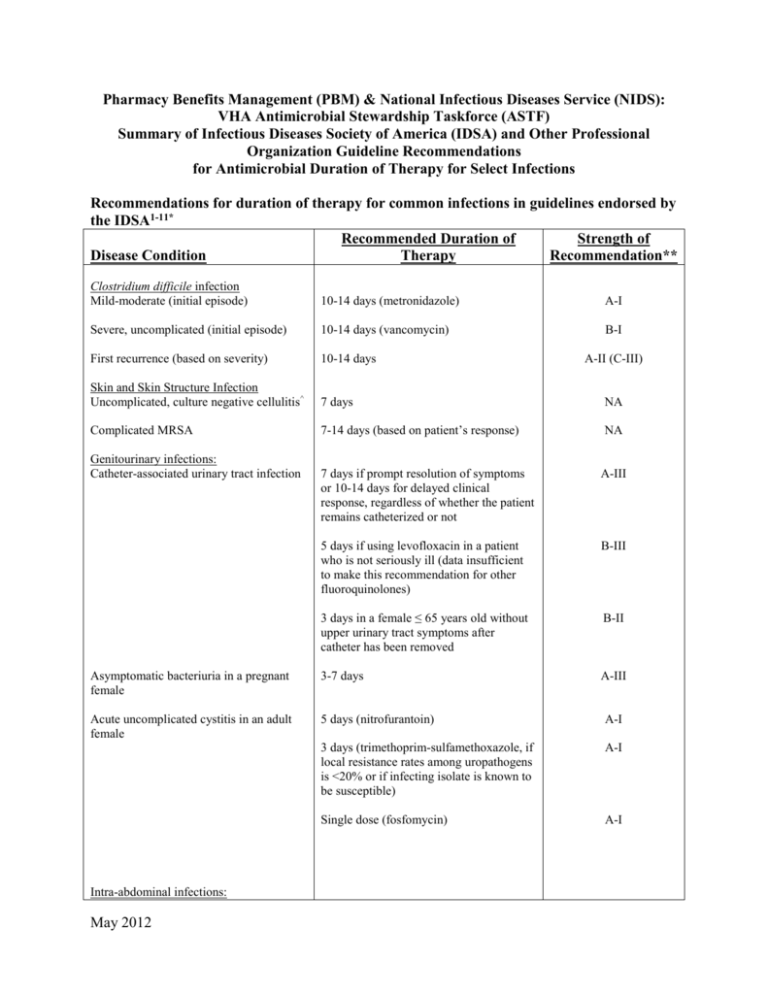
Pharmacy Benefits Management (PBM) & National Infectious Diseases Service (NIDS): VHA Antimicrobial Stewardship Taskforce (ASTF) Summary of Infectious Diseases Society of America (IDSA) and Other Professional Organization Guideline Recommendations for Antimicrobial Duration of Therapy for Select Infections Recommendations for duration of therapy for common infections in guidelines endorsed by the IDSA1-11* Recommended Duration of Strength of Disease Condition Therapy Recommendation** Clostridium difficile infection Mild-moderate (initial episode) 10-14 days (metronidazole) A-I Severe, uncomplicated (initial episode) 10-14 days (vancomycin) B-I First recurrence (based on severity) 10-14 days Skin and Skin Structure Infection Uncomplicated, culture negative cellulitis^ 7 days NA Complicated MRSA 7-14 days (based on patient’s response) NA Genitourinary infections: Catheter-associated urinary tract infection A-II (C-III) 7 days if prompt resolution of symptoms or 10-14 days for delayed clinical response, regardless of whether the patient remains catheterized or not A-III 5 days if using levofloxacin in a patient who is not seriously ill (data insufficient to make this recommendation for other fluoroquinolones) B-III 3 days in a female ≤ 65 years old without upper urinary tract symptoms after catheter has been removed B-II Asymptomatic bacteriuria in a pregnant female 3-7 days A-III Acute uncomplicated cystitis in an adult female 5 days (nitrofurantoin) A-I 3 days (trimethoprim-sulfamethoxazole, if local resistance rates among uropathogens is <20% or if infecting isolate is known to be susceptible) A-I Single dose (fosfomycin) A-I Intra-abdominal infections: May 2012 Established intra-abdominal infection where source control is achieved 4-7 days A-III Acute stomach and proximal jejunal perforations where source control is achieved within 24 hours, in the absence of acid-reducing therapy or malignancy 24 hours of therapy B-II Bowel injuries attributable to penetrating, blunt, or iatrogenic trauma that are repaired within 12 h and any other intraoperative contamination of the operative field by enteric contents ≤24 hours A-I Acute appendicitis without evidence of perforation, abscess, or local peritonitis ≤24 hours A-I Pneumonia Community-acquired pneumonia Minimum of 5 days. Should be afebrile for 48–72 h and have no more than 1 associated sign of clinical instability before discontinuation of therapy B-I/II Hospital-acquired, ventilator-associated, and healthcare-associated pneumonia If patients receive an initially appropriate antibiotic regimen, efforts should be made to shorten the duration of therapy from the traditional 14 to 21 days to periods as short as 7 days, provided that the etiologic pathogen is not P. aeruginosa, and that the patient has a good clinical response with resolution of clinical features of infection Level I Diabetic foot infections (DFI) General recommendation Continue antibiotic therapy until there is evidence that the infection has resolved but not necessarily until a wound has healed Specific situations: Mild DFI 1-2 weeks (though some require an additional 1-2 weeks) Moderate to severe DFI (without osteomyelitis) 2-4 weeks DFI with osteomyelitis 4-6 weeks (shorter if entire infected bone is removed and probably longer if infected bone remains) A-II A-II B-II Catheter-related bloodstream infections (CRBSI) May 2012 Uncomplicated CRBSI due to coagulase negative staphylococci other than S. lugdunensis (catheter removed) 5-7 days, or Observation alone (if no intravascular or orthopedic hardware is present and additional blood cultures (performed on samples collected when the patient is not receiving antibiotics) are obtained after catheter withdrawal to confirm the absence of bacteremia CRBSI with persistent bacteremia and fungemia > 72h following catheter removal, associated endocarditis, or suppurative thrombophlebitis 4-6 weeks from first negative blood culture following catheter removal CRBSI with associated osteomyelitis 6-8 weeks from first negative blood culture following catheter removal B-III C-III A-II for S. aureus; C-III for other pathogens A-II A-II Catheter-associated exit site or tunnel 7-10 days following catheter removal and infection without associated bacteremia or incision and drainage (if indicated) fungemia * NOTE: This table does not address treatment duration for specific conditions (fever or infection in neutropenic or heavily immunosuppressed patients, endocarditis, implantable device-related infections, complicated Staphylococcus aureus infection and/or bacteremia, fungemia, catheter-associated infection with catheter retention, central nervous system infections) where the severity of and complications associated with infection may be high and/or decisions made regarding antimicrobial treatment duration are likely to be highly individualized. Such infections typically require full infectious diseases consultation to determine appropriate length of therapy. ^Non-guideline recommendation; based on ref 9. ** STRENGTH OF RECOMMENDATIONS SUMMARY IDSA Definitions of the Strength of Recommendations and the Quality of the Evidence Supporting Strength of Recommendation Grade A Good evidence to support a recommendation for use Grade B Moderate evidence to support a recommendation for use Grade C Poor evidence to support a recommendation Quality of Evidence Level I Evidence from at least 1 properly designed randomized, controlled trial Level II Evidence from at least 1 well-designed clinical trial, without randomization; from cohort or casecontrolled analytic studies (preferably from >1 center); from multiple time series; or from dramatic results of uncontrolled experiments Level III Evidence from opinions of respected authorities, based on clinical experience, descriptive studies, or reports of expert committees American Thoracic Society Evidence-based Grading System Used to Rank Recommendations Evidence Level Level 1 (highest level) = Evidence comes from well conducted, randomized controlled trials Level II (moderate) Evidence comes from well designed, controlled trials without randomization (including cohort, patient series, and case-control studies). Level II studies also include any large case series in which systematic analysis of disease patterns and/or microbial etiology was conducted as well as reports of new therapies that were not collected in a randomized fashion May 2012 Level III (low) Evidence comes from case studies and expert opinion. In some instances therapy recommendations come from antibiotic susceptibility data without clinical observations References: 1. Hooton TM, Bradley SF, Cardenas DD, et al. Diagnosis, prevention, and treatment of catheterassociated urinary tract infection in adults: 2009 international clinical practice guidelines from the Infectious Diseases Society of America. Clin Infect Dis 2010;50:625-63. 2. Nicolle LE, Bradley S, Colgan R, et al. Infectious Diseases Society of America guidelines for the diagnosis and treatment of asymptomatic bacteriuria in adults. Clin Infect Dis 2005;40:643-54. 3. Gupta K, Hooton TM, Naber KG, et al. International clinical practice guidelines for the treatment of acute uncomplicated cystitis and pyelonephritis in women: a 2010 update by the Infectious Diseases Society of America and the European Society for Microbiology and Infectious Diseases. Clin Infect Dis 2011;52(5):e103-e120. 4. Solomkin JS, Mazuski JE, Bradley JS, et al. Diagnosis and management of complicated intraabdominal infection in adults and children: guidelines by the Surgical Infection Society and the Infectious Diseases Society of America. Clin Infect Dis 2010;50:133-64. 5. Mandell LA, Wunderink RG, Anzueto A, et al. Infectious Diseases Society of America/American Thoracic Society consensus guidelines on the management of community-acquired pneumonia in adults. Clin Infect Dis 2007;44(Suppl 2): S27-S72. 6. American Thoracic Society, Infectious Diseases Society of America. Guidelines for the management of adults with hospital-acquired, ventilator-associated, and healthcare-associated pneumonia. Am J Respir Crit Care Med 2005;171:388-416. 7. Lipsky BA, Berendt AR, Deery HG, et al. Diagnosis and treatment of diabetic foot infections. Clin Infect Dis 2004;39:885-910. 8. Mermel LA, Allon M, Bouza E, et al. Clinical practice guidelines for the diagnosis and management of intravascular catheter-related infection: 2009 update by the Infectious Diseases Society of America. Clin Infect Dis 2009;49:1-45. 9. Jenkins TC, Knepper BC, Sabel AL, et al. Decreased Antibiotic Utilization After Implementation of a Guideline for Inpatient Cellulitis and Cutaneous Abscess. Arch Intern Med. 2011;171(12):1072-79. 10. Cohen SH, Gerding DN, Johnson S, et al. Clinical practice guidelines for Clostridium difficile infection in adults: 2010 update by the Society for Healthcare Epidemiology of America (SHEA) and the Infectious Diseases Society of America (IDSA). Infect Control Hosp Epidemiol 2010;31(5):431-55. 11. Liu C, Bayer A, Cosgrove SE, et al. Clinical Practice Guidelines by the Infectious Diseases Society of America for the Treatment of Methicillin-Resistant Staphylococcus Aureus Infections in Adults and Children. Clin Infect Dis 2011;52:1-38. May 2012

